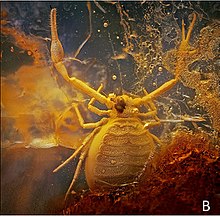
Back رحلان Arabic Forèsia Catalan Foréze Czech Foresis Spanish Phorésie French Foresia Galician Форезия Kazakh Foreza Polish Forésia Portuguese Forezie Romanian




Phoresis or phoresy is a temporary commensalistic relationship when an organism (a phoront or phoretic) attaches itself to a host organism solely for travel.[2] It has been seen in ticks and mites since the 18th century,[3] and in fossils 320 million years old.[2] It is not restricted to arthropods or animals; plants with seeds that disperse by attaching themselves to animals are also considered to be phoretic.[4]
Phoresis is rooted in the Greek words phoras (bearing) and phor (thief).[3] The term, originally defined in 1896 as a relationship in which the host acts as a vehicle for its passenger, clashed with other terminology being developed at the time, so constraints on the length of time, feeding, and ontogeny are now considered.[3] Phoresis is used as a strategy for dispersal,[5][6] seasonal migration,[7] transport to new host/habitat,[8] escaping ephemeral habitats,[9][3] and reducing inbreeding depression.[10] In addition to the benefits afforded to individuals and species, its presence can add to the ecological diversity and complexity of an ecosystem.[4]
- ^ Harms, D.; Dunlop, J. A. (2017). "The fossil history of pseudoscorpions (Arachnida: Pseudoscorpiones)". Fossil Record. 20 (2): 223. doi:10.5194/fr-20-215-2017.
- ^ a b White, P. Signe; Morran, Levi; de Roode, Jacobus (June 19, 2017). "Phoresy". Current Biology. 27 (12): R578–R580. doi:10.1016/j.cub.2017.03.073. PMC 5749251. PMID 28633022.
- ^ a b c d Houck, M A; OConnor, B M (1991). "Ecological and Evolutionary Significance of Phoresy in the Astigmata". Annual Review of Entomology. 36 (1): 611–636. doi:10.1146/annurev.en.36.010191.003143. ISSN 0066-4170.
- ^ a b Houck, Marilyn A. (2009), "Phoresy", Encyclopedia of Insects, Elsevier: 772–774, doi:10.1016/b978-0-12-374144-8.00205-8, ISBN 9780123741448, retrieved 2018-10-14
- ^ Zeh, David W.; Zeh, Jeanne A. (1992). "On the Function of Harlequin Beetle-Riding in the Pseudoscorpion, Cordylochernes scorpioides (Pseudoscorpionida: Chernetidae)". The Journal of Arachnology. 20 (1): 47–51. JSTOR 3705790.
- ^ Binns, E. S. (1982). "Phoresy as migration--some functional aspects of phoresy in mites [Insect dispersion]". Biological Reviews of the Cambridge Philosophical Society. 57 (4): 571–620. doi:10.1111/j.1469-185X.1982.tb00374.x. S2CID 84639744.
- ^ Liu, Sai; Li, Jianling; Guo, Kun; Qiao, Haili; Xu, Rong; Chen, Jianmin; Xu, Changqing; Chen, Jun (2016-05-06). "Seasonal phoresy as an overwintering strategy of a phytophagous mite". Scientific Reports. 6 (1): 25483. Bibcode:2016NatSR...625483L. doi:10.1038/srep25483. ISSN 2045-2322. PMC 4858688. PMID 27150196.
- ^ Saul-Gershenz, Leslie S.; Millar, Jocelyn G. (2006). "Phoretic Nest Parasites Use Sexual Deception to Obtain Transport to Their Host's Nest". Proceedings of the National Academy of Sciences of the United States of America. 103 (38): 14039–14044. Bibcode:2006PNAS..10314039S. doi:10.1073/pnas.0603901103. JSTOR 30051982. PMC 1599908. PMID 16966608.
- ^ Sabagh, Leandro T.; Dias, Roberto Júnio P.; Branco, Christina W. C.; Rocha, Carlos F. D. (2011-04-28). "News records of phoresy and hyperphoresy among treefrogs, ostracods, and ciliates in bromeliad of Atlantic forest". Biodiversity and Conservation. 20 (8): 1837–1841. doi:10.1007/s10531-011-0050-z. ISSN 0960-3115. S2CID 12658034.
- ^ Schwarz, H.H.; Huck, K. (1997-11-01). "Phoretic mites use flowers to transfer between foraging bumblebees". Insectes Sociaux. 44 (4): 303–310. doi:10.1007/s000400050051. ISSN 0020-1812. S2CID 36137431.
© MMXXIII Rich X Search. We shall prevail. All rights reserved. Rich X Search